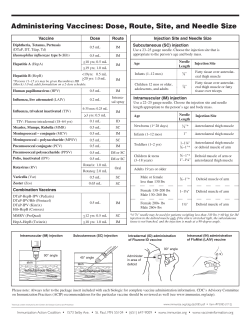
Document 2548
Immune responses to adeno associated virus vectors in canine muscle using MRI For Duchenne muscular dystrophy 1 D. Lee1, M. Kushmerick1, Z. Wang2, and S. Tapscott2 University of Washington, Seattle, WA, United States, 2Fred Hutchinson Cancer Research Center, Seattle, WA, United States Introduction Duchenne muscular dystrophy (DMD) is one of the most common forms of muscular dystrophy in humans. There is no cure for this deadly disease. Gene therapy is one of the two promising treatments in addition to stem cell approach and requires further understanding of immune responses to adeno associated virus (AAV) vectors used for gene delivery. Canine MR imaging was conducted to noninvasively monitor local inflammatory responses following intramuscular AAV vector injections to dogs over time. Inflammation volumes for the AAV injections were measured at 4 and 8 weeks post AAV injections using 3 dimensional T2 weighted images. T2 variations were also investigated for AAV vector injection sites and the contra-lateral muscles with no injections. Method Six wild type dogs were used for this study. AAV vectors were injected on 5 locations of left leg and the other leg used as a non-injection control: 2 on one muscle type and 3 on different type with each injection volume of 250 uL. MRI was conducted using a two flexible element SENSE surface coil (Philips Sense Flex M coil) on a Philips 3 T Achieva (version 2.5 software) at 4 and 8 weeks post AAV injections. T2 weighted images were acquired with turbo spin echo sequences (echo time ranging from 20 to 170 ms) to generate T2 values and gradient echo sequences to obtain 3 dimensional (3D) images of muscle. 3D segmentation was attempted to measure inflammatory volumes subsequent to AAV injections using 3D Slicer (version 3.4). Results Inflammatory regions induced by AAV injections have been clearly discriminated from normal muscles by T2 weighted MR images. The injected regions were segmented from T2 weighted 3D MR images acquired to estimate their volumes 4 weeks post AAV injections as seen in Fig. 1 that shows 3D segmented inflammation regions and their calculated volumes, demonstrating that MRI is a powerful tool to quantify volume changes Figure 2. Progression of inflammatory responses to AAV after Figure 1. Inflammation regions were segmented, shown in of inflammation over time. intramuscular injection in dog. a) T2-weighted images at 4 (b), and reconstructed using T2 weighted 3D MR images Cigar shaped injection weeks (left) and 8 weeks (right) after vector injection. Arrows acquired for a normal dog 4 weeks post injections with AAV point at the two AAV–induced inflammatory sites. T2 values vectors on 5 injection sites. The results demonstrate that MRI sites were formed along were specified for the sites. b) Muscle biopsy analysis at week is a powerful noninvasive tool to quantify changes of muscle fiber directions. 4 (b1-H&E, and b2-CD8 in green), and week 8 (b3-H&E, and inflammation volumes over time. Three orthogonal 2D The volume increase of 33 b4-CD8, DAPI stained nuclei (blue). ST: semitendinosus images, shown in (a), (c) and (d), cover several inflammation ~ 150 % was monitored muscle where AAV vector injected; BF: buffer injected site. sites induced by AAV vector injections. on semitendinosus muscle (red, green and yellow regions from Fig. 1b) than the other injection site of semimembranosus muscle (blue and pink from Fig. 1b). The median T2 value was significantly higher (p < 0.0003) at the sites of AAV injection (60.1 ± 5.4 ms) than those from the un-injected or buffer injected control muscles (33.6 ± 0.5 ms) in the contra-lateral muscle. Figure 2 shows T2 weighted images and biopsy analysis acquired at 4 and 8 weeks post AAV injections. Images shown in Figs. 1 and 2 demonstrate that MRI is a sensitive and useful non-invasive modality for monitoring AAV induced inflammatory responses and progression of inflammation over time in dog muscles. Discussion and Conclusions A certain muscle type has more dystrophic than the other muscle types. Likewise, a different muscle type presented different immune responses to AAV by revealing variations of inflammation volumes as shown in Fig.1. This may suggest that a proper number of intramuscular injections would provide effective treatment on a specific muscle by avoiding excessively heavy injections which may cause any adverse immune responses to injections. Such muscle type dependent treatment information would be valuable to determine intramuscular injection volume, optimum number of injections, distance between adjacent injection sites and injection intervals without wasting unnecessary injections. Acknowledgements This was supported by NIH R01AR056949, R01AR041928 and R21EB008166. We thank Daniel Chen for processing some 3D images. Proc. Intl. Soc. Mag. Reson. Med. 18 (2010) 872
© Copyright 2025





















